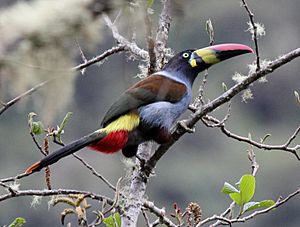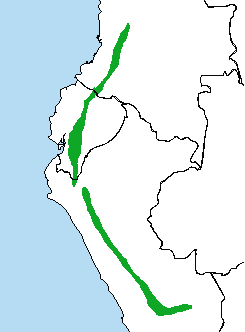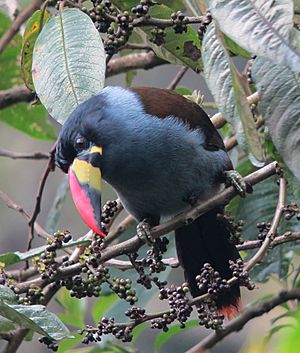Grey-breasted mountain toucan facts for kids
Quick facts for kids Grey-breasted mountain toucan |
|
|---|---|
 |
|
| A. h. lateralis in Peru | |
| Conservation status | |
| Scientific classification | |
| Genus: |
Andigena
|
| Species: |
hypoglauca
|
 |
|
| Range of grey-breasted mountain toucan | |
| Synonyms | |
|
|
The grey-breasted mountain toucan (Andigena hypoglauca) is a special bird from the toucan family, Ramphastidae. It is considered a Near Threatened species, which means it might be at risk in the future. You can find this colorful bird living in the mountains of Colombia, Ecuador, and Peru.
Contents
About the Grey-breasted Mountain Toucan
Scientists first described the grey-breasted mountain toucan a long time ago. It was originally placed in a different group called Pteroglossus. Today, we know there are two main types, or subspecies, of this toucan. One is called A. h. hypoglauca, and the other is A. h. lateralis. Each type has slightly different features.

What Does This Toucan Look Like?
The grey-breasted mountain toucan is a medium-sized bird. It is about 41 to 48 centimeters (16 to 19 inches) long. It weighs between 244 and 370 grams (about 0.5 to 0.8 pounds). Both male and female toucans look very similar.
Their bills are quite unique. The base of the bill is yellow or greenish. It has a black band near where it joins the face. The top part of the bill is red on the outer two-thirds. The bottom part of the bill is black on its outer half.
Both types of this toucan have a black cap on their head. Their face and the back of their neck are also black. A pretty gray-blue band crosses the back of their neck. Their back is a greenish-brown color. Their chest and belly are gray to gray-blue. Their tail is blackish, with chestnut tips on the central feathers.
The A. h. hypoglauca subspecies has a bright yellow rump (the lower back area). Its sides are pale gray-blue, and its thighs are chestnut-colored. The feathers under its tail are red. This toucan has brown eyes surrounded by bare blue skin.
The A. h. lateralis subspecies has a paler yellow rump. Its sides are pale yellow to gray-white. This type has yellow or green eyes.
Where Do Grey-breasted Mountain Toucans Live?
The grey-breasted mountain toucan lives in the Andes Mountains. The A. h. hypoglauca subspecies is found in central and southern Colombia and eastern Ecuador. The A. h. lateralis subspecies lives from eastern Ecuador south into Peru.
These toucans prefer wet, cool mountain forests. This includes cloud forests, elfin forests (which are short, dense forests), and secondary forests (forests that have grown back after being cut down). They usually live at high elevations. You can find them mostly between 2,200 and 3,650 meters (7,200 to 12,000 feet) above sea level. Sometimes, they are seen as low as 1,500 meters (4,900 feet) in Peru.
How Do These Toucans Behave?
Movement and Daily Life
Scientists do not know much about how these toucans move around. They do not seem to have a regular migration pattern. They probably stay in the same general area.
What Do They Eat?
The grey-breasted mountain toucan looks for food from the ground all the way up to the tops of the tallest trees. They might forage alone, in pairs, or in small family groups. Sometimes, they even join mixed groups of different bird species looking for food together. Their main diet includes fruits and berries. They might also eat small animals, but this is not fully confirmed.
Reproduction and Life Cycle
The breeding season for the grey-breasted mountain toucan varies by location. In Colombia, they breed from December to February. In Ecuador and Peru, they breed from June or July to November. Not much else is known about how they raise their young.
Sounds and Calls
The grey-breasted mountain toucan has a distinct song. It sounds like a low "gweeeeeeeat." They also make different calls. These include single "wek" notes or a series of them. They make "kek" notes when they are alarmed or feeling aggressive. Sometimes, their songs and calls include a "bill-whacking" sound, where they hit their bill against something.
Why is This Toucan Near Threatened?
The IUCN (International Union for Conservation of Nature) has listed the grey-breasted mountain toucan as Near Threatened. This means that while it is not in immediate danger, its population might become threatened in the future. We do not know exactly how many of these toucans are left. However, experts believe their numbers are going down.
The biggest threat to these toucans is deforestation. This happens when forests are cut down for farming, mining, or logging. Even though these toucans live in some protected areas, their homes are still shrinking. Scientists are also worried that their populations might become separated, which could lead to problems like inbreeding.
See also
 In Spanish: Tucán pechigrís para niños
In Spanish: Tucán pechigrís para niños


